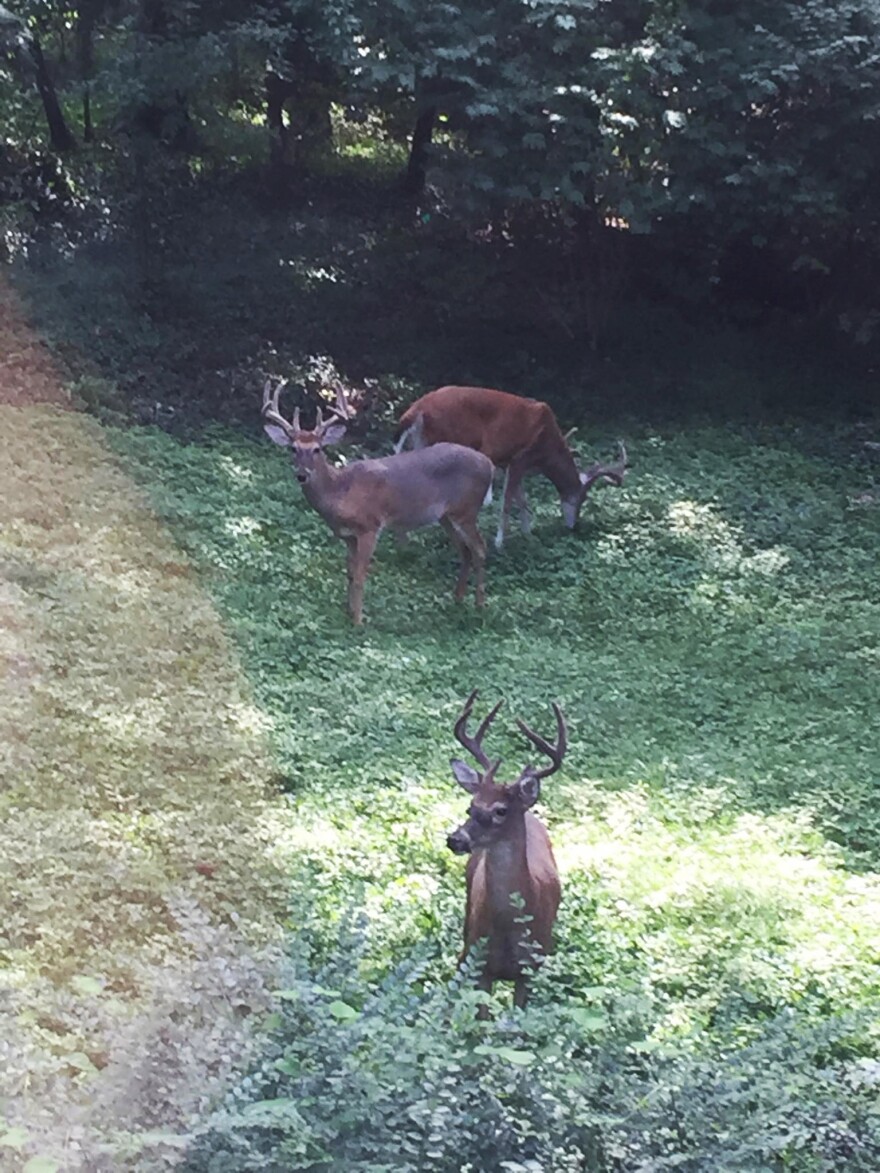Julie Monroe is accustomed to seeing deer around her Kirkwood neighborhood, but not this many.
On a recent evening, Monroe and her son counted 17 deer on the drive home from Manchester.
“It was dark outside, so we don’t know how many were beyond our vision,” she said.
Her experience isn’t unusual. Residents in other areas of west St. Louis County are reporting high numbers of white-tailed deer in their neighborhoods this year. According to biologists, an abundance of food and lack of predators contribute to high suburban deer populations.
Three adult bucks have become a fixture in Monroe’s neighborhood this year. A few times a week, the trio ambles out of the forested area bordering her property to nibble on the clover in her backyard.
“My kids like to hang out of our dining room window and watch the deer,” she said. “We’ll just say, ‘the boys are back!’”
Erin Shank, an urban wildlife biologist with the Missouri Department of Conservation calls suburban areas “perfect deer habitat.”
Not only do gardens and lawns provide an ample food source for deer, she said, but many municipalities have instituted local ordinances that restrict hunter harvest.

“Under these conditions, deer nutrition is good, reproductive performance of the herd is high, mortality is low, so deer numbers invariably will grow,” Shank said.
Land development can also affect deer density by eliminating open space and concentrating deer populations in suburban areas.
Higher numbers of deer in suburban areas may mean an increased risk of motor vehicle collisions, particularly in the fall.
According to the Missouri State Highway Patrol, there were 3,805 deer-involved car crashes across the state in 2016, a nearly 2 percent increase over the previous year. More than half of these crashes occurred from October to December 2016.
To estimate suburban deer densities, the Missouri Department of Conservation organizes deer surveys of certain West St. Louis County municipalities every few years.
Once the leaves have fallen, trained spotters use high-powered flashlights to count the number of deer along pre-established routes.
Using these data, MDC biologists calculate the likelihood of seeing deer in the sample area and the estimated number of deer per square mile.
Loading...
In the past five years, biologists and trained city staff have surveyed deer populations in Chesterfield, Des Peres, Ellisville, Ladue, Kirkwood, Sunset Hills, Town and Country, Manchester and Wildwood.
Some communities, such as Sunset Hills and Wildwood, have seen high deer densities over the last several years. At last check, these regions had approximately 69 and 82 deer per square mile, respectively.
According to MDC biologists, deer densities in certain regions of West St. Louis County appear to have increased over relatively short periods of time. In Manchester, deer densities jumped from 26 deer per square mile in March 2014 to 42 deer per square mile in January 2017.
In contrast, deer densities in Town and Country have dropped, likely as a result of a proactive management plan put in place nine years ago.
“They have a hired contractor that comes to the city to bait and sharpshoot deer at strategic locations throughout the community,” Shank said. “That deer meat is then donated to Operation Food Search. It’s a sizable donation of locally sourced food that goes into the St. Louis community.”
A decade ago, Town and Country had 65 to 70 deer per square mile. Last winter, the city’s deer density had dropped to 26.
Several municipalities in St. Louis County also allow regulated bow-hunting of deer within city limits, including Ballwin, Chesterfield, Creve Coeur, Ladue, Manchester, Maryland Heights, Sunset Hills and Wildwood.
According to the Missouri Department of Conservation, hunters in St. Louis County harvested nearly 2,000 deer during the 2017-2018 season. Of these, roughly half were harvested during the fall archery season.
The 2018 deer archery season runs from Sept. 15-Nov. 9 and Nov. 21-Jan. 15.
Follow Shahla on Twitter: @shahlafarzan



